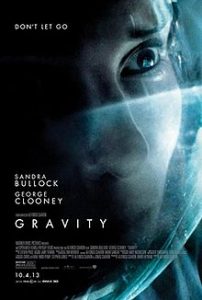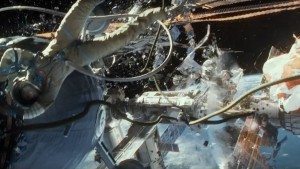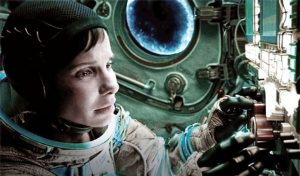
 Ladies and gentlemen, this is why we go to the movies.
Ladies and gentlemen, this is why we go to the movies.
Alfonso Cuarón's "Gravity" is the kind of movie that is so good it makes you reevaluate your perception of cinema as an art form. Hollywood has become such a well-oiled, blockbuster-producing, money-making machine that we tend to forget what makes movies unique: their ability to completely submerse us in a fictional world; to whisk us away from our ordinary lives and plunge us into an adventure beyond our wildest dreams. The best movies should make you forget you're watching a movie. "Gravity" does all of this and more.
If you've ever taken a Film History course, then you remember the story of one of the earliest movies ever made: "L'Arrivé d'un train en gare de La Ciotat" by Auguste and Louis Lumière. This 50-second silent film is mind-numbingly ordinary by today's standards. It features one stationary shot of a locomotive pulling into a station. But to audiences who had never seen a moving picture before, it was nothing short of a miracle. Popular myth has it that those in attendance at the earliest screenings actually ran to the back of the auditorium in terror, convinced that a train was about to run them over. Whether or not this urban legend is true, it's certain that the film inspired in its audiences a sense of awe, of terror, of witnessing something they'd never seen before. "Gravity" is the modern-day equivalent of that experience.
In today's age of superheroes and aliens and transforming robots, we've become so inundated with special effects that the once-extraordinary has become sadly ordinary. Gone are the days when audiences could believe in a man in a rubber lizard suit stomping his way through a miniature city. Nowadays we even have a hard time believing the most cutting-edge, crystal-clear effects; it's all just so much weightless metal, flesh and light. It would take something truly breathtaking to wake us from our coma of un-spectacular spectacle, and that's exactly what Alfonso Cuarón set out to do.
Cuarón ("Children Of Men", "Harry Potter And The Prisoner Of Azkaban") spent four-and-a-half years crafting this film. That's truly a labor of love, practically unheard of in this era of studios churning out franchise entries every single summer. Even before "Gravity", Cuarón was no stranger to innovative filming techniques, attracting attention with his complicated long takes in "Children Of Men", including one four-minute shot where the camera spins effortlessly around a cramped car and then through an adrenaline-pumping shootout. So he knew when he wrote the screenplay for "Gravity" with his son, Jonás Cuarón, that he didn't want to make just another "space movie" filmed with conventional technology -- he wanted to revolutionize the industry, to set the bar a notch higher for cinema. (And isn't that what every filmmaker should strive for?)
 You can read articles for yourself on how "Gravity" was filmed (and you should -- it's fascinating). I won't go too in-depth on Cuarón's methods here, other than to say that they involved years of research and planning and several grueling months of shooting for stars Sandra Bullock and George Clooney. "Apollo 13" was famous in 1995 for filming zero-gravity scenes by putting its actors in a parabolic plane, which achieved weightlessness for 30 seconds at its apex. This approach wouldn't work for Cuarón, as the half-minute limitation was far too short for the long takes he wanted to use. So he used a combination of underwater filming, wires, computer animation, and his biggest innovation -- something called the Light Box. The Light Box is a 20-foot-tall enclosure outfitted on the inside with over 4,000 LED light bulbs programmed to simulate moving images of Earth and space. This had the double benefit of achieving stunning visuals while also providing visual cues for the actors, as opposed to using green screen, where the actors are interacting with nothing but air.
You can read articles for yourself on how "Gravity" was filmed (and you should -- it's fascinating). I won't go too in-depth on Cuarón's methods here, other than to say that they involved years of research and planning and several grueling months of shooting for stars Sandra Bullock and George Clooney. "Apollo 13" was famous in 1995 for filming zero-gravity scenes by putting its actors in a parabolic plane, which achieved weightlessness for 30 seconds at its apex. This approach wouldn't work for Cuarón, as the half-minute limitation was far too short for the long takes he wanted to use. So he used a combination of underwater filming, wires, computer animation, and his biggest innovation -- something called the Light Box. The Light Box is a 20-foot-tall enclosure outfitted on the inside with over 4,000 LED light bulbs programmed to simulate moving images of Earth and space. This had the double benefit of achieving stunning visuals while also providing visual cues for the actors, as opposed to using green screen, where the actors are interacting with nothing but air.
Thanks to Cuarón's meticulous and innovative technique, "Gravity" is chock-full of "How did they DO that?" moments. You will find yourself shaking your head in disbelief at least once every ten minutes. But the film is no empty spectacle, either. Contained within the awe-inspiring visuals is a surprisingly poignant story. Many people have been skeptical that "Gravity" would be anything more than "Open Water" in space, especially since the trailer ends with Sandra Bullock's character seemingly spinning off into oblivion. But fear not: the film sports a relatively brief 90-minute running time, and practically every second is filled with breathtaking action. The film rarely slows down from its breakneck pace, except for a few select moments that focus on and develop the characters.
Speaking of characters, there are really only two: George Clooney as veteran astronaut Matt Kowalski and Sandra Bullock as biomedical engineer Ryan Stone. Matt is on his last mission; Ryan is on her first. When disaster strikes their shuttle, they find themselves the only survivors and have to rely on each other to get back to Earth safely. Clooney is terrific as the motor-mouthed, cocky Kowalski, but make no mistake: this is Bullock's film. Many people scoffed at the idea of Miss Congeniality pulling off a movie of this type, but there's no way Bullock won't end up a front-runner for the Best Actress Oscar this year. Even with sparse dialogue and absolutely no glimpses of her life on Earth, Ryan is a fully-fleshed out character and easily one of the most compelling women on screen this year. Brief hints at a tragic backstory and some absolutely stellar moments on Bullocks' part are enough to make Ryan a living, breathing person you can't help but root for.
 The fight for survival isn't a unique story. It's presented here in a straightforward manner with very few distractions. And yet it unfurls almost imperceptibly into an unexpected theme of rebirth, aided by some clever and beautiful visual cues. One of my favorite moments in the film was a rare quiet one: the simple image of Ryan floating in a fetal position in a circular enclosure, a well-placed tube completing the womb-like portrait. The theme of rebirth is tracked neatly -- but not blatantly -- throughout the film, leading all the way to the affecting final images, which I won't spoil here.
The fight for survival isn't a unique story. It's presented here in a straightforward manner with very few distractions. And yet it unfurls almost imperceptibly into an unexpected theme of rebirth, aided by some clever and beautiful visual cues. One of my favorite moments in the film was a rare quiet one: the simple image of Ryan floating in a fetal position in a circular enclosure, a well-placed tube completing the womb-like portrait. The theme of rebirth is tracked neatly -- but not blatantly -- throughout the film, leading all the way to the affecting final images, which I won't spoil here.
This week I wrote an article listing the best Space Movies of all time. While no one will be dethroning "Star Wars" as #1 anytime soon, thanks purely to its lasting legacy, "Gravity" instantly earns a high ranking on the list. It's easily the most believable space film of all time, with "Apollo 13" its only rival for realism (scientists have already praised "Gravity" for its relative lack of inaccuracies or exaggerations). And I would rarely encourage anyone to shell out even more of their hard-earned money for 3D, but this is a must-see in the extra dimension -- preferably on an IMAX screen if you live in close proximity to one. In the zero gravity of space, there's literally no limit to the axis of movement, and in that way "Gravity" might be the first and only film to truly benefit from that overused medium.
What young child doesn't briefly flirt with the thought of becoming an astronaut when he or she grows up? Even in our adulthood, who among us doesn't occasionally look up at the stars and wonder what it would be like to travel among them? For most of us, watching "Gravity" is as close as we will get. Never mind the fact that Alfonso Cuarón has upped the ante for cinema as an art form; merely for the small kindness of fulfilling a childhood dream, this one-of-a-kind filmmaker deserves our undying gratitude and appreciation.
[youtube]https://www.youtube.com/watch?v=OiTiKOy59o4[/youtube]